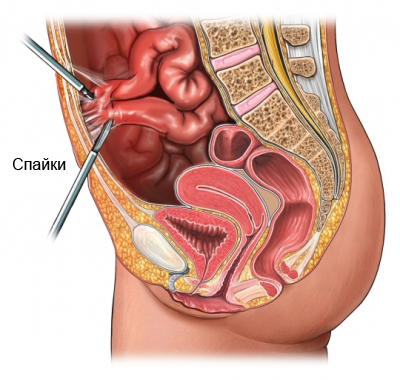Lysis spaek – Cutting adhesions – Adgeziolizis
Description lysis of adhesions
Adhesions – it scars, which form in the organism. They are usually formed in the abdomen or in the pelvis. Adhesions develop naturally after surgery as part of the healing. They may also develop after infection or any other inflammatory processes, such as:
- Endometriosis;
- Diverticulitis;
- Appendicitis.
Lysis spaek – the cutting process of scar tissue in the body. This is done to restore normal functioning of the organs and reduce pain.

Indications for lysis of adhesions
Adhesions can cause:
- Pain;
- Bowel obstruction;
- Infertility.
Surgery can fix intestinal obstruction or cure infertility, by the presence of adhesions. It also reduces the chronic abdominal pain.
Possible complications of lysis of adhesions
If you plan to have surgery, you need to know about possible complications, which may include:
- Internal injuries;
- Possible increase in adhesions;
- Bleeding;
- Infection.
Factors, that may increase the risk of complications include:
- Diseases of the heart or lungs;
- Obesity;
- The operations of the abdominal cavity in the past;
- Smoking;
- Diabetes.
How provoditysya lysis spaek?
Preparing for Surgery
Before the operation it is necessary to pass the following tests:
- Make blood and urine tests;
- Ultrasonography (US) – test, which uses sound waves, to see the internal organs;
- CT scan – type of X-ray inspection, which uses computer, to make pictures of internal organs;
- MRT – test, which uses magnetic waves, to make pictures of internal organs.
Before surgery
Perhaps it will be necessary to stop taking certain medicines a week before surgery, eg:
- Aspirin or other anti-inflammatory drugs;
- Do not take blood thinners, such as warfarin, Clopidogrel.
You can not eat after midnight the day of surgery.
Anesthesia
The operation is performed under general anesthesia, during the operation the patient is asleep. Administered intravenously.
Activity description
This operation is typically performed by laparoscopy. Once the patient is asleep and feels no pain, inserted into the abdominal cavity of the needle and injected carbon dioxide. Abdomen with the swells. This makes it easier to see the internal organs. On the skin, a small incision is made, through which a laparoscope is inserted. The laparoscope lights internal organs, and projecting the image on the screen,. After examining the internal organs, the doctor makes several small incisions in the abdominal wall.. Using small surgical instruments, which are inserted through these holes, the doctor cuts the adhesions. It also frees up organs, which have grown to spikes.
In some cases, you may need, transition to open abdominal surgery (so-called laparotomy). The doctor makes a large longitudinal incision in the abdomen. This allows direct access to all organs, and cut adhesions without using a laparoscope.
How long does the surgery?
The operation takes between one and three hours.
Will it hurt?
Anesthesia will prevent pain during the procedure. After the operation, soreness at the incision sites may be felt for several days.. For pain relief after surgery appoint appropriate painkillers.
The time spent in hospital
The operation is performed in a hospital. If adhesions were cut using laparoscopic surgery, the statement is made on the same day or the next. If there was an open operation, the patient must stay in the hospital for a few days. If there are complications, you will have to stay for a longer period.
Postoperative care
Usually, recovery from surgery takes place at home.. For normal recovery subject to the following conditions:
- Follow your doctor's instructions;
- Keep the incision area clean and dry;
- Take pain medication as directed by your doctor;
- Avoid hard work;
- Don't drink carbonated drinks for several days.
It is necessary to go to the hospital in cases
- The appearance of signs of infection, including fever and chills;
- Redness, edema, strong pain, excessive bleeding, or discharge from incisions;
- Inability to relieve pain using painkillers;
- Nausea and / or vomiting, persist for more than two days after discharge from the hospital;
- Diarrhea, constipation, hemafecia, or black stools;
- Abdominal distention;
- Problems with urination;
- Cough, breathlessness, chest pain.
